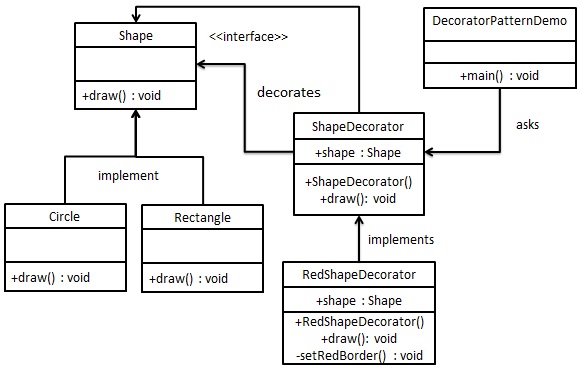装饰器模式
装饰器模式(Decorator Pattern)允许向一个现有的对象添加新的功能,同时又不改变其结构。这种类型的设计模式属于结构型模式,它是作为现有的类的一个包装。
这种模式创建了一个装饰类,用来包装原有的类,并在保持类方法签名完整性的前提下,提供了额外的功能。
我们通过下面的实例来演示装饰器模式的用法。其中,我们将把一个形状装饰上不同的颜色,同时又不改变形状类。
介绍
意图:动态地给一个对象添加一些额外的职责。就增加功能来说,装饰器模式相比生成子类更为灵活。
主要解决:一般的,我们为了扩展一个类经常使用继承方式实现,由于继承为类引入静态特征,并且随着扩展功能的增多,子类会很膨胀。
何时使用:在不想增加很多子类的情况下扩展类。
如何解决:将具体功能职责划分,同时继承装饰者模式。
关键代码: 1、Component 类充当抽象角色,不应该具体实现。 2、修饰类引用和继承 Component 类,具体扩展类重写父类方法。
应用实例: 1、孙悟空有 72 变,当他变成”庙宇”后,他的根本还是一只猴子,但是他又有了庙宇的功能。 2、不论一幅画有没有画框都可以挂在墙上,但是通常都是有画框的,并且实际上是画框被挂在墙上。在挂在墙上之前,画可以被蒙上玻璃,装到框子里;这时画、玻璃和画框形成了一个物体。
优点:装饰类和被装饰类可以独立发展,不会相互耦合,装饰模式是继承的一个替代模式,装饰模式可以动态扩展一个实现类的功能。
缺点:多层装饰比较复杂。
使用场景: 1、扩展一个类的功能。 2、动态增加功能,动态撤销。
注意事项:可代替继承。
实现
我们将创建一个 Shape 接口和实现了 Shape 接口的实体类。然后我们创建一个实现了 Shape 接口的抽象装饰类 ShapeDecorator,并把 Shape 对象作为它的实例变量。
RedShapeDecorator 是实现了 ShapeDecorator 的实体类。
DecoratorPatternDemo,我们的演示类使用 RedShapeDecorator 来装饰 Shape 对象。

步骤 1
创建一个接口:
public interface Shape {
void draw();
}
步骤 2
创建实现接口的实体类。
public class Rectangle implements Shape {
@Override
public void draw() {
System.out.println("Shape: Rectangle");
}
}
public class Circle implements Shape {
@Override
public void draw() {
System.out.println(“Shape: Circle”);
}
}
步骤 3
创建实现了 Shape 接口的抽象装饰类。
public abstract class ShapeDecorator implements Shape {
protected Shape decoratedShape;
public ShapeDecorator(Shape decoratedShape){
this.decoratedShape = decoratedShape;
}
public void draw(){
decoratedShape.draw();
}
}
步骤 4
创建扩展了 ShapeDecorator 类的实体装饰类。
public class RedShapeDecorator extends ShapeDecorator {
public RedShapeDecorator(Shape decoratedShape) {
super(decoratedShape);
}
@Override
public void draw() {
decoratedShape.draw();
setRedBorder(decoratedShape);
}
private void setRedBorder(Shape decoratedShape){
System.out.println("Border Color: Red");
}
}
步骤 5
使用 RedShapeDecorator 来装饰 Shape 对象。
public class DecoratorPatternDemo {
public static void main(String[] args) {
Shape circle = new Circle();
Shape redCircle = new RedShapeDecorator(new Circle());
Shape redRectangle = new RedShapeDecorator(new Rectangle());
System.out.println("Circle with normal border");
circle.draw();
System.out.println("\nCircle of red border");
redCircle.draw();
System.out.println("\nRectangle of red border");
redRectangle.draw();
}
}
步骤 6
执行程序,输出结果:
Circle with normal border
Shape: Circle
Circle of red border
Shape: Circle
Border Color: Red
Rectangle of red border
Shape: Rectangle
Border Color: Red如何理解装饰模式?
动态地给一个对象增加一些额外的职责,这些职责可以再动态的撤销。在为对象增加额外职责方面,装饰模式替代了继承,它比子类继承父类更为灵活,它用无需定义子类的方式来给对象动态的增加职责,使用对象之间的关联关系来取代继承。
现在理解的还不够深刻,还要等有一天境界更高了,在回来思考吧.
/**
* @ClassName: DecoratorTester
* @Description: TODO
* @author zhangdi
*/
public class DecoratorTester {
@Test
public void testBiu(){
Component cd = new ConcreteDecorator(new ConcreteComponent());//用Component接收
cd.biu();
}
/**
* @ClassName: Component
* @Description: interface
*/
interface Component {
public void biu();
}
class ConcreteComponent implements Component {
public ConcreteComponent() {
// TODO Auto-generated constructor stub
}
@Override
public void biu() {
System.out.println("biubiubiu...");
}
}
/**
* @ClassName: Decorator
* @Description: 装饰类
*/
class Decorator implements Component {
public Component component;
public Decorator(Component component) {
super();
this.component = component;
}
@Override
public void biu() {
component.biu();
}
}
/**
* @ClassName: ConcreteDecorator
* @Description: 具体装饰类
*/
class ConcreteDecorator extends Decorator {
public ConcreteDecorator(Component component) {
super(component);
}
public void biu() {
boom();//先上炮弹
super.biu();//再开枪
}
public void boom() {
System.out.println("boom...");
}
}
}参考:http://www.runoob.com/design-pattern/decorator-pattern.html (大部分来自这里)